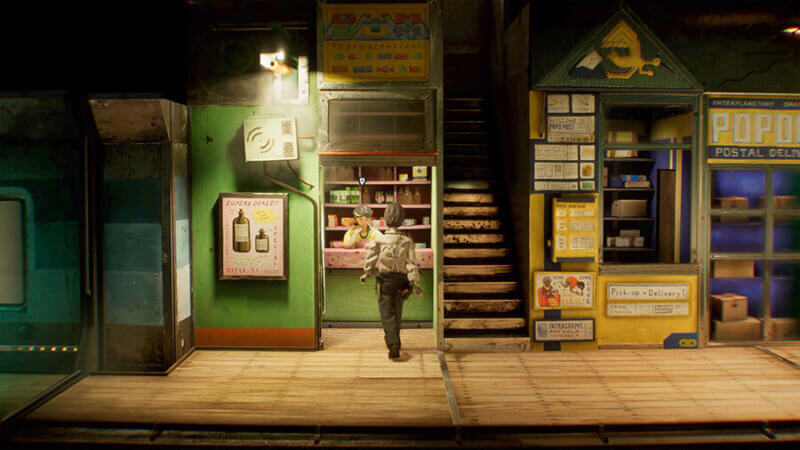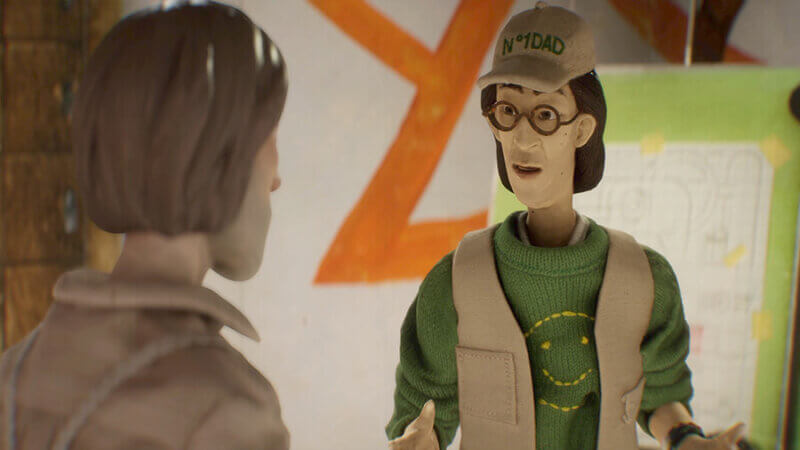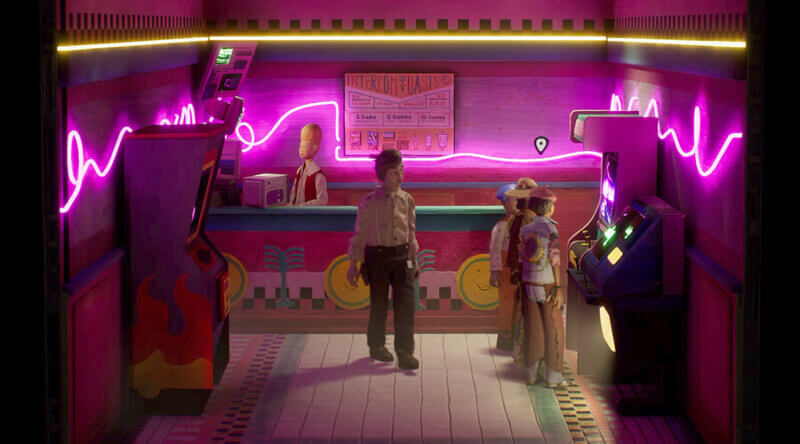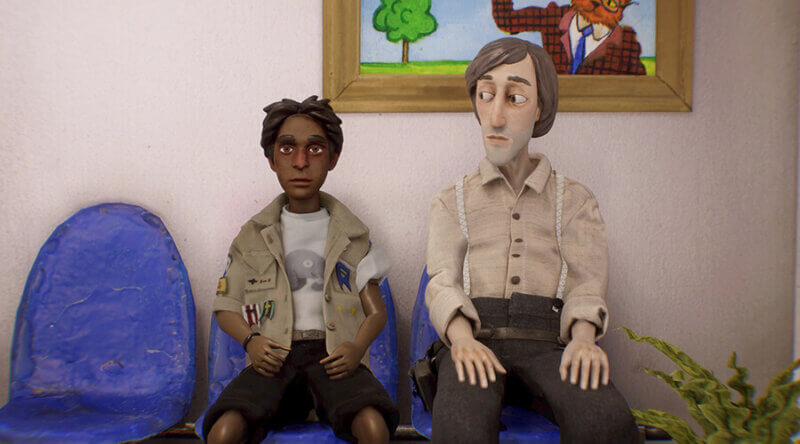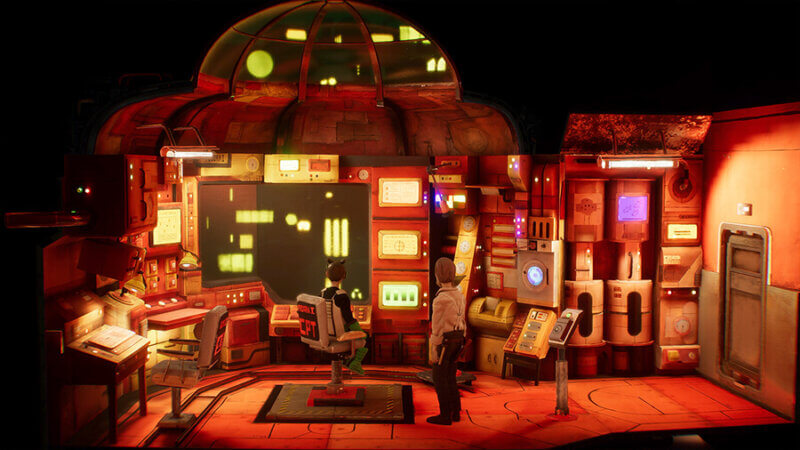Harold Halibut Interview with Slow Bros: On Tactile Gaming
We live in a world of paradox where sometimes the opposite to an idea must be integrated. Strangely enough, it seems the world of stop-motion, in all its tactile, handmade efficacy has begun trickling into virtual realms. Game studios have discovered ingenious methods of incorporating stop-motion animation into their interactive experiences.
Back in 1996, the Neverhood Chronicles, were released in Japan. This Claymation point-and-click adventure was an early attempt to fuse the styles. However, efforts to transport players into stop motion environments are becoming far more sophisticated in recent years. In 2019, GYMNASIA, an installation from Clyde Henry Productions, provided audiences with uncanny experiences of VR, merging 360-degree video with stop-motion and CGI: the real with the unreal. Commercial game studios such as State of Play have also traded in pixels for a handmade aesthetic. In the BAFTA winning puzzle platformer, Lumino City, everything is built from paper, card and powered by real motors. The city was filmed in real time as a backdrop, whilst Lumi, a sprite-based playable character, is set to explore this fantastic world.
Perhaps these creators are tapping into a desire for more sensory, tactile experiences? The materiality of stop-motion has long since incited delight in the viewer and by inviting the form into interactive space, one might create a new kind of dynamic experience. Cologne based Slow Bros are working hard to push the envelope of stop-motion gaming with their upcoming game Harold Halibut… and the breadth of the project is astounding.
Every asset is made by hand. Stop-motion puppets, sets and props are lovingly crafted and then imported into the game using photogrammetry. This clever method of 3D scanning can account for missing information using photographs of an object from different angles, then calibrating the information on a computer using 3D geometry.
The story follows the adventures of a janitor, Harold, and is tinged with tragic irony. In the midst of the Cold War, tensions are high and a giant spaceship is built to set a course across the stars, safely delivering its human passengers to an inhabitable planet. The journey takes 200 years. When they finally get there, they find the planet is made up entirely of water (and everyone is still dressed circa. 1970).
We spoke to Ole Tillmann, Slow Bros Art Director, about the inspirations and technical challenges behind this extraordinary game.
You have said that Harold Halibut was first imagined over a dinner-table conversation. I am sure many would have liked to have been a fly on the wall for that occasion! Could you tell us how the subaquatic world of Harold Halibut was born?
Yes, I would hope for a lot of projects to start that way! It was born from a few loose cornerstones. Wanting to make a game, also sort of wanting to make films- I think the four of us all shared a story telling background of some kind or another. We also really easily and quickly agreed on water as the basic element, visually but also esoterically it just felt like a dense thing to start with. Also having a small and confined underwater society and looking at relationships within that bubble.
When it comes to world-building, how collaborative is this process within your team?
It was very collaborative and probably the biggest catalyst for the whole project. We worked very harmoniously from the get-go, sitting around a table and making things up. For me in particular it was nice to then try and summarize thoughts via drawings and feed that back into the creative loop. Like the new drawing of an environment, we had talked about would spark further ideas in conversation about specific rooms or people in that space and so forth.
It continued to be collaborative in that the world building is so closely related to story writing which in turn is interwoven with game design.
What led to the introduction of photogrammetry to your pipeline? What challenges have arisen from using this technology?
Experiments for the most part. At first, we tried to have just stop-motion, so characters in front of a green screen doing various walking or grabbing motions. We were then looking for a way to light the characters dynamically so when a player chose to walk past a lamp the light would affect them accordingly. We played with having just parallax two dimensional backgrounds, then a projection of a photographed background on a rudimentary digital 3D object and when we saw how well all that worked we had our friend Ilja Burzev basically consult us on how, theoretically, the whole thing could be transferred into a digital 3D space…
We simultaneously started to get a sense of the amount of animations that might be required via conventional stop-motion and had to make the hard decision to switch to photogrammetry. If you’re interested in where a similar technical approach might have led you should take a look at ‘Vokabulantis’, from a group of very talented stop-motion animators based in Denmark.
Challenges so far only relate to technical-game-making-feasibility. Like we were having trouble with having such a huge amount of really detailed, large, photographic textures in the game for it to run on all the consoles and everything but that’s been solved since.
Could you tell us more about how you have been able to preserve the imperfections of traditional stop-motion techniques- for example the texture, space and physicality of real objects as well as the animation style within gameplay?
I now think a lot of that is our team and how well everyone works with each other. I think in the past I didn’t fully appreciate how many tiny factors come together in the final thing. I just thought it was a shared patience for detail or something. The most basic layer is good photographs and surface scans from a befriended company that developed a really amazing 3D scanner. Then it really helped that all 4 people that subsequently worked with that material had each of the actual objects in front of them at the computer to do comparisons, experiment with the real texture against a light source etc. Aside from that we then treated all the 3D stuff as if it were real, in a stop motion set and that scale, too.
As a multi-disciplined team your inspirations must be quite diverse! Could you name some which you feel have directly influenced Harold?
This is so hard! Ok, so for the sake of not renaming obvious pop cultural (e.g. Wes Anderson or Zelda which we both admire like all the world) I put together a list of more niche influences:
Archigram (British conceptual architecture firm during 1960s), Korean/Japanese/Belgian/Scandinavian/Australian architecture (see Atelier Bowwow, Terunobu Fujimori, Bureau A, DVVT Architects, Assemble, Kazuo Shinohara, NAAD, Schemata ), the Japan-Criterion-collection if there is such a thing, all of the Disney scale anime films that swept over here in the 90s including Myazaki, Satoshi Kon, Katsuhiro Otomo, Mamoru Oshii etc., more vaguely: Western surrealist painting, Futurism/Italian architect/designer Ettore Sottsass (before Memphis in particular), Jean Giraud (Moebius) particularly the Giger/Jodorowsky collaborations, Dieter Rahms type of Designs, all the beauty shots of food in manga, the gross close-ups in 90s animation like Ren & Stimpy, generally western weekend breakfast tv.. I think that’s a good slice.
How have you managed to secure funding for the project?
Through government film/game funding and art funding. Since we started Germany has expanded its game funding a little and I feel like with everyone I’ve talked to at events from around the world, usually their governments are often at least in the process of pushing something similar in their countries. Its surprisingly slow (considering the age of games and their position as the most lucrative media thing in the world by now which is usually what the relevant institutions are concerned with) but yeah, some countries are even offering funding for relocating to their place.
Do you often find yourself torn between the physical objects and their CG counterparts? When it comes to lighting for example, do you do tests in real life before turning to the computer?
Yes, I made a lot of the physical objects like the characters/puppets which is why I am pretty attached to that side of things. But it adds so many possibilities in the long run that I’m glad it ultimately ends up in the computer.
We do also use them for tests and they’re all over the office which is nice because a lot of times games are made in grey office spaces.
Do you think the hand-crafted aspects of your game will change the way people interact with them?
Yes, I would hope so. But in a very abstract sense. Like one of the most common responses to people playing the small demo that we’ve been able to show at festivals and trade shows is that there’s a very specific, positive sense to being able to puppeteer a puppet.
Also, it supports the idea of mostly playing for the sake of other-worldly-immersion (at least to me that’s a thing I like a lot about what we made.) It pays off to just noodle about and look at everything just because eeeevery last 1 cm coffee cup was carefully made and then passed through between 5-7 other people’s hands or eyes to then arrive in front of whoever is playing. And I truly believe that’s apparent somehow.
What was behind the decision to have a singular ending to the game, rather than multiple possible endings?
Oof, because one ending is hard enough to figure out! Maybe if we’d arrived at different ends in our writing process we might have included them.
As the spaceship Harold inhabits is made up of interconnected sets, would it be theoretically possible to connect them all together in physical space…to form a giant installation of sorts?
Haha hmm, yes, I think a lot of it could but we also built at roughly 3 different scales so we could have almost all the rooms but empty, probably. They are already available as a 3D installation, though, and we`ve been considering a VR exhibit of some kind. We’ll have to publish the game first, though 🙂
Lastly, is there a release date in sight for Harold Halibut?
No, I’m still not allowed to say, unfortunately.
While we await patiently for Harold Halibut’s release, it is perhaps humbling to take account of the amount of work and creativity going into a game such as this. Slow Bros draw some of their influences from a 1960s group called Archigram. This group of radical architects made hypothetical designs of fantastic, impossible structures, one such being the Walking City, a humungous collection of self-contained pods, forged together to create a city with insect-like legs to walk upon.
This out-of-the-box thinking has clearly inspired the Harold Halibut project; science-fiction realities promised to us in the wake of the 1960s space-race imbue the imagination with limitlessness and technological idealism. It takes a maverick and an artist to want to transport a society across the stars but perhaps also to make a game like Harold Halibut.


